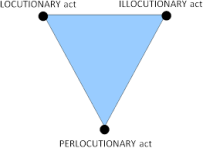Types of Speech Acts
Austin (1962) categorises three acts in the performance of an utterance. “To say something is to do something, or in saying something we do something, or even by saying something we do something” (Austin, 1962, p. 109). He names these acts, respectively, the locutionary, illocutionary, and perlocutionary acts

1. Locutionary Speech Act
Locutionary act is the act of making well-formed utterances and producing meaningful linguistic expressions. It is the act of saying something (Austin, 1962). In locutionary acts, the focus is on the literal meaning of words (Yule, 1996).For example, in saying ‘I am sorry!', the locutionary act performed is the utterance of this sentence. Austin (1962) differentiates three aspects of the locutionary act: A phonetic act, a phatic act, and a rhetic act. Phonetic acts are acts of pronouncing sounds, e.g., the sound /s/; phatic acts are acts of uttering words or sentences in accordance with the phonological and syntactic rules of the language to which they belong, e.g., the word pen; and rhetic acts are acts of uttering a sentence with sense and more or less definite reference, e.g., the red pen.
2. Illocutionary Speech Act
An illocutionary act is a purpose or a function in the speakers' mind. It is the communicative force of an utterance. One can utter to command, offer, promise, greet, thank, etc. (Yule, 1996 & Prince, 2003). For example, in saying I am sorry!, the illocutionary act is the act of performing an apology. There are further examples of illocutionary acts such as: Ordering, requesting, offering, condoling, giving permission, betting, vowing, proposing, and so on. There are two types of illocutionary acts, linguistic and nonlinguistic and both are intentional. They can be illustrated through the example of threatening using a sentence or a gesture. When using a sentence, it is a linguistic illocutionary act; however, when using a gesture, it is a non-linguistic illocutionary act
3. Perlocutionary Speech Act
Perlocutionary act is the effect an utterance leaves on the hearer (Yule, 1996). For example; in saying ‘I am sorry!', the perlocutionary act is the final effect of the utterance on the listener. This example could have two different perlocutions: The speaker succeeds in persuading the listener to accept his apology or fails in doing so.






